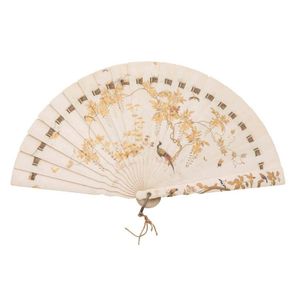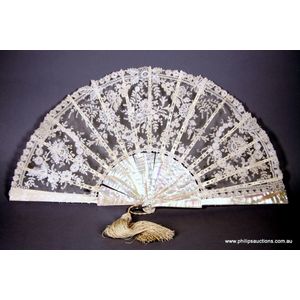Belle Epoque Mother-of-Pearl and Lace Fan
A French Mother-of-pearl and Brussels lace fan, circa 1880s, the Belle Epoque folding fan with mother-of-pearl sticks and ivory supports for the delicate cream floral Belgian lace, with a cream silk tassel, width 56 cm
You must be a subscriber, and be logged in to view price and dealer details.
Subscribe Now to view actual auction price for this item
When you subscribe, you have the option of setting the currency in which to display prices to $Au, $US, $NZ or Stg.
This item has been sold, and the description, image and price are for reference purposes only.
- Belle Epoque - The Belle Époque, also known as the "Beautiful Era," was a period in European history that lasted from the late 19th century to the outbreak of World War I in 1914. The term is most commonly associated with France, but is also used to refer to the same period in other countries, particularly in Western Europe and Latin America.
During the Belle Époque, Europe experienced a time of great prosperity and cultural, artistic, and scientific advancements. It was an era of peace and optimism, characterized by industrial growth, urbanization, and new technologies such as electricity, automobiles, and the telephone. The period is also associated with a flourishing of art and culture, particularly in the fields of literature, music, and the visual arts. - Mother-Of-Pearl - Mother-of-pearl, technical name "nacre", is the inner layer of a sea shell. The iridescent colours and strength of this material were widely used in the nineteenth century as an inlay in jewellery, furniture, (especially papier mache furniture) and musical instruments.
In the early 1900s it was used to make pearl buttons. Mother-of-pearl is a soft material that is easily cut or engraved.
Nowadays it is a by-product of the oyster, freshwater pearl mussel and abalone industries. - Circa - A Latin term meaning 'about', often used in the antique trade to give an approximate date for the piece, usually considered to be five years on either side of the circa year. Thus, circa 1900 means the piece was made about 1900, probably between 1895 and 1905. The expression is sometimes abbreviated to c.1900.
- Brussels / Belgian Lace - Belgium has a rich history of lace-making dating back to the 16th century, and Brussels became an important centre for lace production in the 18th and 19th centuries. The lace was made using fine threads such as linen or silk and was often decorated with intricate designs that incorporated flowers, leaves, and other motifs. The lace was made by hand, and it took many hours to complete a single piece.
The lace is made using a technique called bobbin lace, in which threads are wound onto bobbins and then woven together to create the lace. The lace is made using a pillow or cushion, on which the bobbins are held in place while the lace is being made.
Brussels lace was highly sought after and was used to decorate clothing, linens, and other household items. It was also used to make intricate and delicate decorations for churches and other public buildings. - Ivory - Ivory is a hard white material that comes from the tusks of elephants, mammoth, walrus and boar, or from the teeth of hippopotamus and whales. The ivory from the African elephant is the most prized source of ivory. Although the mammoth is extinct, tusks are still being unearthed in Russia and offered for sale.
Ivory has been used since the earliest times as a material for sculpture of small items, both in Europe and the east, principally China and Japan.
In Asia ivory has been carved for netsuke, seals, okimono, card cases, fan supports, animals and other figures and even as carved tusks.
In the last 200 years in Europe ivory has been used to carve figures, for elaborate tankards, snuff boxes, cane handles, embroidery and sewing accessories, in jewellery and as inlay on furniture. Its more practical uses include being used for billiard balls, buttons, and a veneers on the top of piano keys.
The use and trade of elephant ivory have become controversial because they have contributed to Due to the decline in elephant populations because of the trade in ivory, the Asian elephant was placed on Appendix One of the Convention on International Trade in Endangered Species (CITES), in 1975, and in January 1990, the African elephant was similarly listed. Under Appendix One, international trade in Asian or African elephant ivory between member countries is forbidden. Unlike trade in elephant tusks, trade in mammoth tusks is legal.
Since the invention of plastics, there have been many attempts to create an artificial ivory
This item has been included into following indexes:
Visually similar items

Sold by
in
for
You can display prices in $Au, $US, $NZ or Stg.

Finely carved Chinese ivory fan the sticks carved with figures in a landscape, together with 2 smaller ivory examples (faults)
Sold by
in
for
You can display prices in $Au, $US, $NZ or Stg.

An ivory fan with pierced decoration
Sold by
in
for
You can display prices in $Au, $US, $NZ or Stg.

A Japanese Shibiyama ivory and gilt fan, Meiji period, open 28 cm high, 50 cm wide
Sold by
in
for
You can display prices in $Au, $US, $NZ or Stg.
